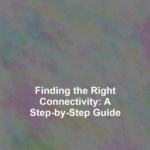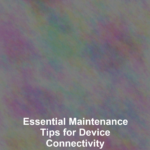In todayG??s fast-paced digital landscape, you need a connection thatG??s reliable, fast, and cost-effective. As you navigate the labyrinth of internet connectivity options, youG??ll find a plethora of choices at your fingertips: cable, DSL, fiber-optic, satellite, and more.
Deciphering the nuances of each to determine what best suits your lifestyle and work demands can be a daunting task. YouG??re not just choosing a service; youG??re setting the stage for your daily interactions with the world. Whether youG??re streaming your favorite shows, conquering virtual meetings, or keeping your smart home devices in sync, the stakes are high, and the wrong choice can lead to frustration.
Stick with me, and together, weG??ll explore the critical factors that will guide you to make an informed decision, ensuring that your online experiences are seamless, not stressful.
Assess Your Internet Needs
Before selecting an internet service, itG??s essential to evaluate how your daily activities translate into bandwidth requirements. YouG??ll need to be clear about what you do online. Are you constantly streaming videos or are you mostly browsing websites and checking emails? If youG??re a heavy streamer or a gamer, youG??ll need a faster connection with higher bandwidth to avoid lag and buffering. On the other hand, if your usage is light, you could save money with a lower-tier plan.
Consider the number of devices thatG??ll be connected simultaneously. Each device adds to the overall demand on your network. You donG??t want your video call to drop because someone else in your home started a Netflix binge-watch. Make sure the plan you choose can handle your householdG??s digital lifestyle.
DonG??t forget about future-proofing either. With technology evolving, you might adopt more connected devices or services that require faster internet speeds. Opting for a slightly higher bandwidth than you currently need can save you the hassle of upgrading your service too soon.
Lastly, be aware of data caps. Unlimited data is ideal, but if youG??re on a budget, at least ensure the cap is high enough to cover your monthly usage without incurring extra fees.
Understand Connection Types
When choosing your internet service, itG??s crucial to understand the different types of connections available to you, as they directly impact speed, reliability, and cost. Broadly, there are four main types: DSL, cable, fiber-optic, and satellite.
DSL (Digital Subscriber Line) uses your phone line to deliver internet. ItG??s widely available but typically offers slower speeds, especially if youG??re far from the providerG??s office.
Cable internet, on the other hand, runs through the same coaxial cable network as your TV service. ItG??s faster than DSL and doesnG??t lose speed over distance, but you might experience slower speeds during peak hours when everyone in your neighborhood is online.
Fiber-optic is the speed king, providing the fastest connection by transmitting data through light signals along glass or plastic fibers. ItG??s incredibly reliable but not as widely available and can be more expensive.
Lastly, thereG??s satellite internet, which is ideal for rural areas without other internet infrastructure. ItG??s generally slower and more affected by weather than other types, but it can reach almost anywhere.
Each type has its trade-offs. YouG??ll need to balance between whatG??s available in your area, the speed you require, and how much youG??re willing to spend. Choose wisely to ensure youG??re not left buffering!
Compare Service Providers
Having understood the various connection types, itG??s essential to evaluate and compare the service providers that offer these technologies in your area. DonG??t just look at their marketing brochures or websites; dig deeper. Start by checking their coverage maps to ensure they provide service where you live or work.
Next, youG??ll want to scrutinize their plans and pricing. Look beyond the promotional ratesG??find out what youG??ll actually pay once the initial period ends. Are there hidden fees or data caps? Remember, the cheapest option isnG??t always the best if it doesnG??t meet your needs.
Consider the providerG??s reputation for reliability and customer service. Read online reviews and ask neighbors about their experiences. A provider with a robust support system can save you plenty of headaches down the line.
Also, assess the flexibility of their contracts. Are you locked in for a year, or can you switch if youG??re unsatisfied? The ability to leave without steep penalties offers peace of mind and keeps the provider motivated to maintain high standards.
Consider Speed and Bandwidth
Evaluate your internet needs critically to determine the speed and bandwidth necessary for your daily tasks and leisure activities. Speed is how fast data transfers to and from your devices. ItG??s measured in megabits per second (Mbps).
Bandwidth, on the other hand, is the maximum rate at which you can download data from the internet to your computer, and itG??s crucial for handling multiple devices.
If youG??re simply browsing and checking emails, lower speeds might suffice. However, if youG??re streaming videos, playing online games, or working from home with large file transfers, youG??ll need higher speeds to avoid frustration from buffering or slow downloads.
Remember, advertised speeds arenG??t always what you get. The actual speed during peak hours may be lower. ThatG??s why you should look for plans offering the best average speed. Also, donG??t forget about upload speeds, especially if you upload videos or use video conferencing regularly.
Bandwidth becomes critical when multiple devices are connected. If your household has several users streaming, gaming, or working simultaneously, youG??ll need a plan with enough bandwidth to accommodate everyoneG??s activities without a hitch.
Check Contract and Costs
After determining the speed and bandwidth that best fit your needs, itG??s crucial to examine the contract terms and costs associated with potential internet service providers. DonG??t let enticing introductory offers trap you into a long-term commitment that doesnG??t serve you well. Here are three key aspects you should consider:
-
Contract Length: Many providers will offer lower rates if you commit to a longer contract. Weigh the pros and cons; a longer contract might mean lower monthly costs, but youG??re also locked in, which can be problematic if youG??re dissatisfied with the service or if better options arise.
-
Early Termination Fees: ItG??s not just about how long youG??re in the contract, but what itG??ll cost to get out. Check for hefty termination fees that could make it costly to switch providers before your contract is up.
-
Hidden Costs: Look beyond the advertised price. Providers may have additional charges, such as equipment rental fees, installation costs, or data overage fees. Ensure youG??re aware of the complete cost structure to avoid unpleasant surprises on your bill.
Conclusion
So, youG??ve scoped out your needs, learned the connection lingo, and eyed different providers.
Now, make sure the speed and bandwidth fit just right, like GoldilocksG?? porridgeG??not too hot, not too cold.
DonG??t get trapped in a pricey, lengthy contract. Choose a plan thatG??s as flexible as you are, without breaking the bank.
Remember, the best connectivity isnG??t just about going fast; itG??s about having a seamless online experience that keeps pace with your life.











